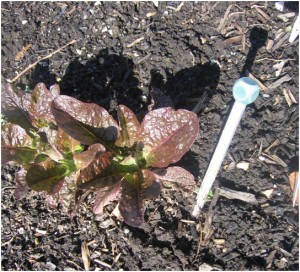
Early in the month, while the soil is still cold, is the perfect time to get sowing in the greenhouse. Heavier soils in particular are going to take time to warm up. Frost tender crops like Aubergine, celery, peppers, sweet corn, French and runner beans, courgettes, squashes and other tender vegetables can all be germinated in a propagator under glass, while hardier vegetables from broad beans and carrots, to kohl rabi and leeks can be sown outdoors under protection. The key to successful germination are constant soil temperatures; sow when the soil is too cold, germination is erratic and worst of all, your seed may rot. It is helpful to know that parsnips need a soil temperature around 6 C (42F) Cabbage, peas and beans need a minimum of 5 C(41F), leeks and onions, 7C(44F). Those from warmer climates, like cucumbers, need at least 13 C (55F). Even potatoes have a temperature requirement of 6C(43F) at 4″ depth at least three days before planting. It is worth buying a soil thermometer or sowing crops in trays and modules, to gain some time.
If the ground is too wet to work early in the month, why not tidy up your house plants? Not all of them will need re-potting, most last for 2-3 years in the same pot. Soaking the root-ball for half an hour makes removal easier, though you may need to slide an old kitchen knife between the pot and the root-ball to ease it out, before transplanting into pots one or two sizes larger. New terracotta pots should be soaked overnight and re-used plastic pots should be washed with a little detergent and rinsed thoroughly.
Put a layer of broken pot fragments, polystyrene pieces or bottle corks in the base to help drainage, tease out some of the roots from the root-ball, then re-fill around it with compost, firming each layer gently with your fingers as you go. Don’t pack the compost too hard or the roots won’t be able to grow into the new compost or plant them too deeply. Leave a decent gap between the rim of the pot and compost for watering and top-dress with gravel ornamental mulches to conserve moisture. Water thoroughly, allow plants to recover for a few days then put them on display. If your plants don’t need re-potting, top dress by carefully removing the top 11/2 -2″ of compost with an old culinary fork and replace with new compost mixed with slow release fertiliser
April is the ideal time to divide bamboos, grasses and clumps of herbs that have grown too large for their allotted space. Lift and divide them carefully by pushing two forks back to back into the centre of the clump then prising it apart. Alternatively, chop the plant into several sections using an old spade. Old material from the centre of the clump can be composted, the soil improved with the addition of grit and well rotted compost if necessary and the new divisions replanted or exchanged with friends.
Happy Gardening!
Matt


